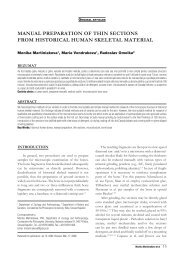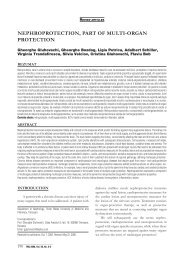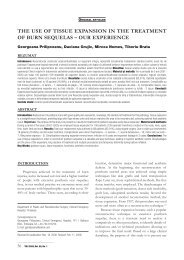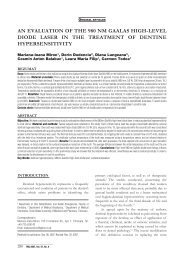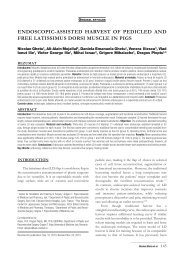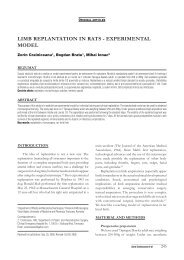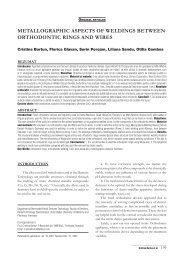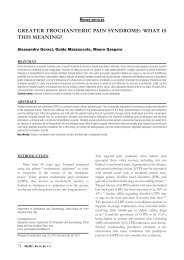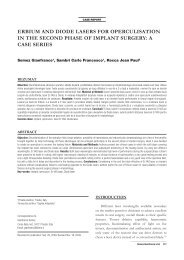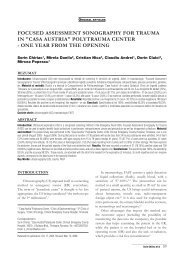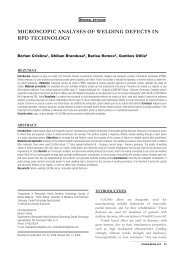thyroid nodules in patients with neuroendocrine tumors
thyroid nodules in patients with neuroendocrine tumors
thyroid nodules in patients with neuroendocrine tumors
You also want an ePaper? Increase the reach of your titles
YUMPU automatically turns print PDFs into web optimized ePapers that Google loves.
INTRODUCTION<br />
Genetic cancer susceptibility is more frequent and<br />
more variable <strong>in</strong> <strong>tumors</strong> of endocr<strong>in</strong>e organs than<br />
<strong>in</strong> any other category of human neoplasm. An even<br />
more complex situation is registered <strong>in</strong> the case of<br />
neuroendocr<strong>in</strong>e <strong>tumors</strong>. 1<br />
CASE REPORTS<br />
THYROID NODULES IN PATIENTS WITH<br />
NEUROENDOCRINE TUMORS - TWO CASE REPORTS<br />
Catal<strong>in</strong>a Poiana 1,2 , Mara Carsote 1 , Cor<strong>in</strong>a Chirita 2 , Andrei Goldste<strong>in</strong> 1,2 , Maria<br />
Belgun 2 , Dana Terzea 1,2,3 , Dan Hortopan 2 , Dumitru Ioachim 2 , Crist<strong>in</strong>a Corneci 1,2 ,<br />
Bogdan Stanescu 1,2<br />
REZUMAT<br />
Nu există suficiente date în priv<strong>in</strong>ţa tumorilor tiroidiene la pacienţii diagnosticaţi cu tumori neuroendocr<strong>in</strong>e, despre care se ştie ca având un fond genetic<br />
complex, încă <strong>in</strong>complet elucidat. Prezentăm cazurile a 2 pacienţi cu tumori neuroendocr<strong>in</strong>e la care s-a diagnosticat şi un nodul solitar tiroidian. Deşi<br />
prima suspiciune a fost de metastază tirodiană, puncţia cu ac f<strong>in</strong>, ca şi examenul histo-patologic postoperator au arătat o patologie tirodiană <strong>in</strong>tr<strong>in</strong>sică.<br />
Primul caz este al unei paciente de 59 ani, care a suferit în urmă cu 1 an spleno-pancreasectomie pentru carc<strong>in</strong>om neuroendocr<strong>in</strong> b<strong>in</strong>e diferenţiat. In<br />
timp ce markerii neuroendocr<strong>in</strong>i au fost crescuţi postoperator, s-a diagnosticat un nodul tiroidian de 3 cm. Puncţia cu ac f<strong>in</strong> a arătat epiteliu hiperplastic<br />
folicular. Examenul histologic a descris aspect de adenom microfolicular trabecular, embriofetal. Al doilea caz este al unui pacient de 51 ani, care a suferit<br />
hemicolectomie dreaptă pentru tumoră neueondocr<strong>in</strong>ă de valvă ileocecală, la vârsta de 47 ani. Indexul PCNA a fost mare (50-60%). Nu s-a înregistrat<br />
s<strong>in</strong>drom hormonal de-a lungul a 4 ani de evoluţie, dar s-a diagnosticat un nodul tiroidian stâng de 1 cm, la care examenul histopatologic postoperator a<br />
stabilit diagnosticul de carc<strong>in</strong>om papilar.<br />
Cuv<strong>in</strong>te cheie: adenom folicular, carc<strong>in</strong>om papilar, tumoră neuroendocr<strong>in</strong>ă<br />
ABSTRACT<br />
There are no special data related to the <strong>thyroid</strong> <strong>tumors</strong> <strong>in</strong> <strong>patients</strong> diagnosed <strong>with</strong> neuroendocr<strong>in</strong>e <strong>tumors</strong>, which are known to have a complex genetic<br />
background, yet <strong>in</strong>completely elucidated. We present two <strong>patients</strong> known <strong>with</strong> entero-pancreatic <strong>tumors</strong> who were diagnosed <strong>with</strong> a solitary <strong>thyroid</strong><br />
nodule. Also the first suspicion was a metastasis of the primary tumor, the f<strong>in</strong>e needle aspiration biopsy (FNAB) and later the anatomical report after<br />
surgery po<strong>in</strong>ted an <strong>in</strong>tr<strong>in</strong>sic <strong>thyroid</strong>al pathology. The first case, a 59-years old female has one year history of pancreatic and spleen resection for well<br />
differentiated neuroendocr<strong>in</strong>e carc<strong>in</strong>oma. While hav<strong>in</strong>g high serum neuroendocr<strong>in</strong>e markers after surgery, a left <strong>thyroid</strong> node of 3 cm is found. The FNAB<br />
suggested hyperplasic follicular epithelium. The pathological exam after surgery found a micro-follicular and trabecular embryo-fetal adenoma. The<br />
second case, a 51-years old male patient suffered a right hemicolectomy for neuroendocr<strong>in</strong>e tumor of ileocecal valve at age of 47. The PCNA <strong>in</strong>dex was<br />
high (of 50-60 %) <strong>with</strong> no hormonal syndrome for 4 years, when a left <strong>thyroid</strong> nodule of 1 cm was discovered. The histological exam revealed a papillary<br />
carc<strong>in</strong>oma.<br />
Key Words: follicular adenoma, papillary carc<strong>in</strong>oma, neuroendocr<strong>in</strong>e tumor<br />
1 Carol Davila University of Medic<strong>in</strong>e and Pharmacy, Bucharest, 2 CI Parhon<br />
National Institute of Endocr<strong>in</strong>ology, Bucharest, 3 Victor Babes National<br />
Institute of Research and Development, Bucharest<br />
Correspondence to:<br />
Catal<strong>in</strong>a Poiana, MD, PhD, FACE, Assoc. Professor of Endocr<strong>in</strong>ology, CI<br />
Parhon National Institute of Endocr<strong>in</strong>ology, 34-36 Aviatorilor Blvd., Bucharest<br />
Email: endoparhon@gmail.com<br />
Received for publication: Apr. 03, 2009. Revised: Sep. 14, 2009.<br />
Thyroid <strong>nodules</strong> are a usual occurrence (of 4%<br />
up to 10% of population), especially <strong>in</strong> endemic<br />
areas, <strong>with</strong> an age-related <strong>in</strong>cidence; one tenth up<br />
to one third of them might be malignant. 2 A higher<br />
frequency of <strong>thyroid</strong> cancer is related to radiation<br />
exposure, but the <strong>in</strong>creas<strong>in</strong>g prevalence of <strong>thyroid</strong><br />
<strong>in</strong>cidentalomas is probably the effect of a larger access<br />
to health care. 3 The <strong>patients</strong> <strong>with</strong> neuroendocr<strong>in</strong>e<br />
<strong>tumors</strong> could have a higher risk of a second neoplasm,<br />
on a genetic background. We present two sporadic<br />
cases <strong>in</strong> which a second tumor was found, but <strong>with</strong><br />
no particular phenotype connected to the orig<strong>in</strong>at<strong>in</strong>g<br />
neuroendocr<strong>in</strong>e tumor.<br />
CASE REPORTS<br />
The first patient was a 59-years old female, known<br />
<strong>with</strong> arterial hypertension for the last 6 years. One year<br />
ago she presented abdom<strong>in</strong>al diffuse pa<strong>in</strong> associated<br />
_____________________________<br />
Catal<strong>in</strong>a Poiana et al 249
<strong>with</strong> weight loss (10 kg/2 months). The abdom<strong>in</strong>al<br />
ultrasound exam<strong>in</strong>ation discovered a pancreatic<br />
solid tumor of 9 cm, associated <strong>with</strong> mesenteric<br />
adenopathies. Pancreatectomy at the body and tail level<br />
and splenectomy were performed. Secondary diabetes<br />
mellitus was registered. The pathological report revealed<br />
trabecular and alveolar microscopic structure <strong>with</strong> rare<br />
mitosis (2-3/10 HPF) and lymph nodes <strong>in</strong>vasion at<br />
the spleen hill (stage IIIb: T 4 N 1 M 0 ). 4 The tumor cells<br />
showed positive immuno-sta<strong>in</strong><strong>in</strong>g for chromogran<strong>in</strong> A,<br />
synaptophis<strong>in</strong>, neuronal specific enolase, viment<strong>in</strong> and<br />
CK 19. Based on these, diagnosis of well differentiated<br />
pancreatic neuroendocr<strong>in</strong>e carc<strong>in</strong>oma was established.<br />
After surgery, the abdom<strong>in</strong>al and thoracic computed<br />
tomography showed no other <strong>tumors</strong> or metastasis.<br />
On admission, the neuroendocr<strong>in</strong>e markers revealed<br />
high seroton<strong>in</strong> of 492 ng/mL (normal between 40 and<br />
200 ng/mL), slightly <strong>in</strong>creased serum chromogran<strong>in</strong><br />
A of 114 ng/mL (normal between 40 and 100 ng/<br />
mL) and normal 24-h ur<strong>in</strong>ary 5-hydroxy <strong>in</strong>dolacetic of<br />
2 mg/L (normal between 1 and 10 mg/L). Because<br />
of hormonal secretion (yet asymptomatic), therapy<br />
<strong>with</strong> Octreotidum LAR 20 mg/month was started.<br />
Three months after <strong>in</strong>itiation, the neuroendocr<strong>in</strong>e<br />
markers became normal. Also the general physical<br />
exam was normal, but a left <strong>thyroid</strong> nodule of 3 cm<br />
was discovered. The <strong>thyroid</strong> function, the <strong>thyroid</strong><br />
antibodies and serum calciton<strong>in</strong> were normal. The<br />
99m Technetium <strong>thyroid</strong> scan revealed cold <strong>in</strong>ferior<br />
left nodule. (Fig. 1) The ultrasound guided f<strong>in</strong>eneedle<br />
aspiration biopsy (FNAB) showed hyperplasic<br />
multiple-layers follicular epithelium of trabecular<br />
type, <strong>with</strong> nuclear clear<strong>in</strong>g and proliferate risk. Total<br />
<strong>thyroid</strong>ectomy was performed. The pathological<br />
exam po<strong>in</strong>ted micro-follicular and trabecular embryofetal<br />
adenoma <strong>with</strong> micro-hemorrhages. Thyroid<br />
substitution was started.<br />
Figure 1. 99m Tc Thyroid scan: cold <strong>in</strong>ferior left node.<br />
_____________________________<br />
250 TMJ 2010, Vol. 60, No. 2 - 3<br />
The second patient was a 51-years old male<br />
patient, who suffered 4 years ago a right hemicolectomy<br />
<strong>with</strong> L-T ileotransverse anastomosis. The onset was<br />
<strong>with</strong> abdom<strong>in</strong>al pa<strong>in</strong>, <strong>in</strong>test<strong>in</strong>al transit disturbances.<br />
The histological exam showed a polyploidy tumor of<br />
4 cm, at the level of ileocecal valve, <strong>with</strong> local <strong>in</strong>vasion<br />
of the wall. Two of the lymph nodes had metastasis,<br />
but no other metastases were further found (stage<br />
IIIB: T 3 N 1 M 0 ). 4 The pathological evaluation showed<br />
ulcerated <strong>in</strong>test<strong>in</strong>al carc<strong>in</strong>oid. (Fig. 2)<br />
Figure 2. Hystological Exam - hematoxyl<strong>in</strong> eos<strong>in</strong>: Carc<strong>in</strong>oid of ileocecal<br />
valve (A.40×; B.100×; C.200×).<br />
The immunohistochemistry showed positive<br />
reaction for chromogran<strong>in</strong> A, NK1, negative for
synaptophys<strong>in</strong>, CD56. The PCNA proliferation<br />
marker was high (50-60%). (Fig. 3)<br />
Figure 3. Immunohistochemistry: carc<strong>in</strong>oid of ileocecal valve. A.<br />
Chromogran<strong>in</strong> zonal + 200×. B. NK1diffuse + 100×. C. PCNA of 50-<br />
60% 200×.<br />
For four years he was followed-up by<br />
neuroendocr<strong>in</strong>e markers, which were negative. On<br />
admission, the cl<strong>in</strong>ical exam discovered a left <strong>thyroid</strong><br />
nodule of one cm. The serum TSH, <strong>thyroid</strong> antibodies<br />
and calciton<strong>in</strong> were normal. The FNAB suggested<br />
papillary carc<strong>in</strong>oma, which was later confirmed by the<br />
histological report after surgery (a tumor of 1.2 by<br />
0.8 cm <strong>with</strong> marg<strong>in</strong>al <strong>in</strong>vasion was removed). Based<br />
on patient’s age, tumor size, and histological aspects,<br />
the patient had <strong>in</strong>termediate risk of recurrence. 5 The<br />
thyroglobul<strong>in</strong> after suppression therapy <strong>with</strong>drawal was<br />
0.2 ng/mL. The <strong>thyroid</strong> 131 Iod<strong>in</strong>e scan was positive for<br />
<strong>thyroid</strong> and negative for the rest of the body. Adjuvant<br />
radioiod<strong>in</strong>e remnant ablation was used (100mCi).<br />
Further risk-adapted management is necessary.<br />
DISCUSSIONS<br />
In the first case, the FNAB suggested a follicular<br />
neoplasm, which turned out to be benign. The cut-<br />
off between benign or malign is made by capsular<br />
or vascular <strong>in</strong>vasion, that can only be po<strong>in</strong>ted<br />
by histological exam. 6 Even the FNAB cannot<br />
dist<strong>in</strong>guish between follicular cancers or adenomas<br />
and other procedures as core-needle biopsies provide<br />
no additional diagnosis before surgery. 7 The benign<br />
aspect is confirmed after surgery <strong>in</strong> more than one<br />
third of cases if atypia <strong>in</strong> not found <strong>in</strong> FNAB, as <strong>in</strong><br />
our case. 8 Generally, the follicular cancer is found <strong>in</strong><br />
8 up to 30% of all follicular neoplasms. 9,10 A lower<br />
chance of malignancy have females and <strong>patients</strong> older<br />
than 45 years, or if the <strong>nodules</strong> are smaller than 4 cm,<br />
as <strong>in</strong> the presented case. 11 Both the pancreatic tumor<br />
and the follicular adenoma had trabecular grow<strong>in</strong>g<br />
structure. The pancreatic neuroendocr<strong>in</strong>e <strong>tumors</strong> are<br />
usually larger than 5 cm, as here, but located mostly<br />
<strong>in</strong> the pancreatic head. The nest<strong>in</strong>g type is much more<br />
frequent than trabecular structure. 12<br />
The second case refers to papillary carc<strong>in</strong>oma,<br />
which is the most frequent <strong>thyroid</strong> cancer. 13 By 2005,<br />
men were diagnosed <strong>with</strong> <strong>thyroid</strong> cancer at a rate of<br />
5.1 per 100.000, up from 2.5 <strong>in</strong> 1988. 14 There was also<br />
an average annual 9.9% <strong>in</strong>crease of small <strong>tumors</strong>. 15<br />
We have presented <strong>patients</strong> hav<strong>in</strong>g two neoplasms,<br />
suggest<strong>in</strong>g a possible connection. It is known that <strong>in</strong><br />
the digestive tract, 5 up to 10% of neuroendocr<strong>in</strong>e<br />
<strong>tumors</strong> have a hereditary background. 1 But most of the<br />
cases are sporadic, <strong>with</strong> so called “suspected hereditary<br />
background”. 1 Data regard<strong>in</strong>g <strong>tumors</strong> association are<br />
limited. We raise the question of a <strong>thyroid</strong> neoplasm<br />
l<strong>in</strong>k, but it is also possible an epidemiological<br />
overlap, even if the two <strong>patients</strong> came from nonendemic<br />
area. Studies suggested an <strong>in</strong>creased risk<br />
_____________________________<br />
Catal<strong>in</strong>a Poiana et al 251
of a second neoplasm after a first neuroendocr<strong>in</strong>e<br />
tumor. Some authors have found that 36% of <strong>patients</strong><br />
<strong>with</strong> ileal <strong>tumors</strong> have an associated malignancy. 16<br />
Endogenous or environmental risk factors might<br />
also be <strong>in</strong>volved. 17 Among them, genetic background<br />
suggested by familial cluster<strong>in</strong>g is considered. One<br />
study found 3.7% of <strong>patients</strong> <strong>with</strong> neuroendocr<strong>in</strong>e<br />
<strong>tumors</strong> as hav<strong>in</strong>g a first degree relative <strong>with</strong> the same<br />
malignancy. 18 The observation was confirmed by a<br />
nation-wide epidemiological Swedish study. 19 Similar<br />
large population studies from Denmark and USA<br />
failed to confirm the <strong>in</strong>creased cancer risk. 18,20<br />
CONCLUSION<br />
The neuroendocr<strong>in</strong>e <strong>tumors</strong> field is still a complex<br />
area. If there is a high risk of a second neoplasm,<br />
especially <strong>thyroid</strong>ian, it is still a matter of debate.<br />
ACKNOWLEDGEMENTS<br />
This material was partially presented as Poster<br />
at the IV th National Congress of Psycho-Neuro-<br />
Endocr<strong>in</strong>ology, May 2009, Bucharest, Romania.<br />
REFERENCES<br />
1. Paramo JC, Mesko T. Age, tumor, and <strong>in</strong>-office ultrasonography are<br />
predictive parameters of malignancy <strong>in</strong> follicular neoplasms of the<br />
<strong>thyroid</strong>. Endocr<strong>in</strong>e practice 2008;14(4):447-51.<br />
2. Schl<strong>in</strong>kert RT, van Heerden JA, Goellner JR, et al. Factors that predict<br />
malignant <strong>thyroid</strong> lesions when f<strong>in</strong>e-needle aspiration is ”suspicious<br />
for follicular neoplasm.” Mayo Cl<strong>in</strong> Proc 1997;72:913-6.<br />
3. Horvath K. Higher <strong>thyroid</strong> cancer <strong>in</strong>cidence merits further research,<br />
Endocr<strong>in</strong>e News 2009:18.<br />
4. Kloppel G, R<strong>in</strong>di G, Anlauf M, et al. Site-specific biology and pathology<br />
of gastroenteropancreatic neuroendocr<strong>in</strong>e <strong>tumors</strong>. Virchows Archiv<br />
2007;451(Suppl 1):S9-27.<br />
5. Tuttle RM. Risk-adapted management of <strong>thyroid</strong> cancer. Endocr<strong>in</strong>e<br />
_____________________________<br />
252 TMJ 2010, Vol. 60, No. 2 - 3<br />
Practice 2008;14(6):764-74.<br />
6. Chen H, Nicol TL, Udelsman R. Follicular lesions of the <strong>thyroid</strong>. Does<br />
frozen section evaluation alter operative management? Ann Surg<br />
1995;222:101-6.<br />
7. Khoo TK, Baker C, Hallanger-Johnson J, et al. Comparison of<br />
ultrasound-guided f<strong>in</strong>e-needle aspiration biopsy <strong>with</strong> core-needle<br />
biopsy <strong>in</strong> the evaluation of <strong>thyroid</strong> <strong>nodules</strong>. Endocr<strong>in</strong>e Practice<br />
2008;14(4):426-31.<br />
8. Shi Y, D<strong>in</strong>g X, Kle<strong>in</strong> M, et al. Thyroid f<strong>in</strong>e-needle aspiration <strong>with</strong> atypia<br />
of undeterm<strong>in</strong>ed significance. A necessary or optional category?<br />
Cancer Citopathology 2009, Epub ahead of pr<strong>in</strong>t 26 August, 2009.<br />
9. Zdon MJ, Fredland AJ, Zaret PH. Follicular neoplasms of the <strong>thyroid</strong>:<br />
predictors of malignancy? Am Surg 2001;67:880-4.<br />
10. McHenry CR, Raeburn C, Strickland T, et al. The utility of rout<strong>in</strong>e<br />
frozen section exam<strong>in</strong>ation for <strong>in</strong>traoperative diagnosis of <strong>thyroid</strong><br />
cancer. Am J Surg.1996;172:658-61.<br />
11. Paramo JC, Mesko T. Age, tumor, and <strong>in</strong>-office ultrasonography are<br />
predictive parameters of malignancy <strong>in</strong> follicular neoplasms of the<br />
<strong>thyroid</strong>. Endocr<strong>in</strong>e Practice 2008;14(4):447-51.<br />
12. Oberg K, Modl<strong>in</strong> IM. Non-function<strong>in</strong>g Pancreatic Endocr<strong>in</strong>e Tumors.<br />
In: Oberg K, Modl<strong>in</strong> IM, editors. A Century of Advances <strong>in</strong><br />
Neuroendocr<strong>in</strong>e Tumor Biology and Treatment, Felsenste<strong>in</strong> C.C.C.P.,<br />
2007, p.86-99.<br />
13. Khayyata S, Barroeta JE, LiVolsi VA, et al. Papillary hyperplastic<br />
nodule: pitfall <strong>in</strong> the cytopathological diagnosis of papillary thryoid<br />
carc<strong>in</strong>oma. Endocr<strong>in</strong>e Practice 2008;14(7): 863-8.<br />
14. Enewold L, Zhu K, Ron E, et al. Ris<strong>in</strong>g <strong>thyroid</strong> cancer <strong>in</strong>cidence <strong>in</strong> the<br />
United States by demographic and tumor characteristic, 1980-2005,<br />
Cancer Epidemiol Biomarkers Prev 2009;18(3):784-91.<br />
15. Chen AY, Jemal A, Ward EM. Increas<strong>in</strong>g <strong>in</strong>cidence of differentiated<br />
<strong>thyroid</strong> cancer <strong>in</strong> the United States, 1988-2005. Cancer 2009;115(16):<br />
3801-7.<br />
16. Kothari T, Mangula JC. Malignant <strong>tumors</strong> associated <strong>with</strong> carc<strong>in</strong>oid<br />
<strong>tumors</strong> of the gastro<strong>in</strong>test<strong>in</strong>al tract. J Cl<strong>in</strong> Gastronterol 1981;3(Suppl<br />
1):43-6.<br />
17. Chen CC, Neugut AI, Rotterdam H. Risk factors for adenocarc<strong>in</strong>omas<br />
and malignant carc<strong>in</strong>oids of the small <strong>in</strong>test<strong>in</strong>e: prelim<strong>in</strong>ary f<strong>in</strong>d<strong>in</strong>gs.<br />
Cancer Epidemiol Biomark Prev 1994;3:205-7.<br />
18. Babovic-Vuksanovic D, Constant<strong>in</strong>oiu CL, Rub<strong>in</strong> J, et al. Familial<br />
occurence of carc<strong>in</strong>oid <strong>tumors</strong> and association <strong>with</strong> other malignant<br />
neoplasms. Cancer Epidemiol Biomark Prev 1999;8:715-9.<br />
19. Hemm<strong>in</strong>ki K, Li X. Familial carc<strong>in</strong>oid <strong>tumors</strong> and subsequent cancers:<br />
a nation-wide epidemiologic study from Sweden. Int J Cancer 2001;<br />
94:444-8.<br />
20. Westergaard T, Frisch M, Melbye M. Carc<strong>in</strong>oid <strong>tumors</strong> <strong>in</strong> Denmark<br />
(1978-1989) and the risk of subsequent cancers. A population-based<br />
study. Cancer 1995;76:106-9.



